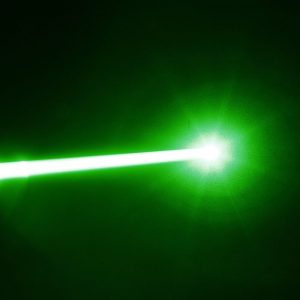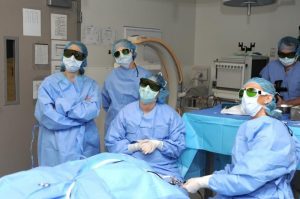By, Bobbi Childers, BSN,RN,CNOR,CMLSO
Respecting Laser Light
Over the years, lasers have become an important part of medical practices. The light produced by lasers is amplified by the stimulated emission of radiation. This light can be invisible, or it can be a bright visible color such as green or red. A laser system can be as small as a microchip or as immense as a ten-story building (National Facility & Photon Science, nd). Since the light starts as a low-energy pulse and is amplified a quadrillion times, it creates a beam that is both useful and potentially hazardous. Lasers can be dangerous if not used properly, leaving the patient and staff in a vulnerable situation. This is why it is vital for medical facilities with class 3B or class 4 lasers to have a laser safety program.


Responsibilities of the LSO
Each organization should have a designated LSO who has the responsibility for the oversight and the control of laser hazards(American National Standard Institute 136.3, 2018). AORN Recommended Guidelines recommends that all health care facilities performing laser procedures establish a laser safety program. As the Laser Safety Officer (LSO), I determined that the level one trauma center where I worked did not have a laser safety program. Therefore, there was no consistent standard of practice established for laser procedures, and we were out of compliance with standards and regulations concerning the safe use of lasers.
Getting Approval
Once I discovered our hospital was lacking a laser safety program, I started researching the standardized practice for the use of lasers in health care facilities. Guidelines from the American National Standard for Safe Use of Lasers in Health Care, AORN’s Guidelines for Perioperative Practice, and the State of Texas regulation were vital resources. This research provides guidelines to help the staff meet the expectations of the hospital and myself.
At this time, I was already a Certified Medical Laser Safety Officer, but I still needed more insight on our particular laser systems, so in November 2015, I attended Laser Institute of America’s (LIA) Medical Laser Safety Officer Training. The training provided the confidence I needed to get my laser safety program off the ground. Later, I met with my Operating Room Director and the Vice President of Nursing Services to give my recommendation for this project. At first, they were reluctant about creating a new program and were not sure it was necessary. Then I shared with them my vision of a laser safety committee, that evidence-based practice of laser safety by interdisciplinary teams could help ensure safe, efficient, and effective patient care, and they soon agreed.
The Laser Safety Committee
I had the approval of the administration, and I created my plan of action. I composed a letter explaining the purpose and importance of an LSC. The message went to the hospital’s interdisciplinary teams which consisted of: a surgeon who uses lasers, Anesthesia, Credentialing, Nursing Administration, Performance Improvement, Biomed, the Administrator of Surgical Services, and the educators of each department that houses a laser. On July 11, 2016, we had our first laser safety committee meeting. The meeting’s goal was to provide information on the importance of laser safety, to standardize safe patient care, and to submit information to the LSC on the regulations and guidelines for various medical laser systems. Standardizing nursing language for documentation was critical for direct patient care and it has helped promote laser safety by communicating why it is essential, what is involved, and the desired outcomes of laser safety.
The importance of policies concerning laser safety was explained to the LSC. The only existing policies in the hospital were in the surgical department. Each department wrote a plan specifically for their department, and the committee began writing a house-wide policy with the laser safety requirements. Following the completion of the policies and procedures, the education process began. Education was a big challenge, because the other departments, (Cath lab, Gastroenterology, Physical Therapy, and the Cancer Center) had no formal training in laser safety. To remedy this, laser safety in-services were given to each department and now continues annually. Education for the staff members on laser safety is now the responsibility of the Clinical Instructors.
Facing the Challenges of Change
Change always brings some challenges along the way. Educating the staff was not a big issue; it was their acceptance of the new policies and practices related to the use of the lasers; they had been using these laser systems for several years already. The biggest obstacle was wearing laser protective eyewear (LPE) during endoscopic procedures. The argument was that the laser fiber wire was inside the body when the laser fired; therefore, the staff did not need to wear LPE. According to ANSI Z136.3-2018 (C1.6.1), “it should be emphasized that using endoscopes, microscopes, or video monitors does not preclude the laser beam’s emission from a break in the optical fiber” (p.65-66). The LSO can determine if the LPE is required (p.66). The staff wears LPE on all laser procedures in compliance with our policy. The decision to use the LPE for all cases ensures the team remembers to wear the LPE when the fiber is not inside the body. We found this made it simpler.

Another obstacle was related to the laser procedures done in the Pediatric Intensive Care Unit. The ophthalmologist was doing procedures in the PICU with no window coverings. Uncovered windows were a problem that had to be solved immediately. The solution was to take the patient to the obstetrical department and use one of the procedure rooms. The window to this area has a laser window covering. This solution worked well once the physician understood that this was safest option for the patients and the staff.
Conclusion
Lasers are changing the lives of people every day, however there are hazards associated with the use of these machines. Safety during laser procedures is never an option and neither is the safety of the patient. The LSO and the LSC are instrumental in training and educating the staff, making lasers safer for everyone involved in the procedures. A successful laser program takes a dedicated LSO, supportive LSC and a cooperative interdisciplinary team. Before I started my mission on creating the laser safety program, I knew I had to do my research on lasers, study the recommendations on the safe use of lasers and determine who to contact with any questions that might arise. LIA, AORN, ANSI Standards for Safe Laser Use, and the Texas Department of Radiation were my resources in building a successful program. Always keep in mind that a team working together can be more successful than working alone.
About the Author
I am Bobbi Childers, BSN,RN,CNOR,CMLSO of University Medical Center in Lubbock, Texas which is a level 1 trauma center. I have been a nurse for 36 years and the past 19 years worked in the operating room at UMC. I received my Laser Safety Officer certification 6 years ago and since then I have expanded my knowledge on the importance of laser safety and the value of a laser safety program.
–
Source: https://issuu.com/marketlia/docs/lia_today_mayjun/23?fr=sYmU1NzE2MDExNTI







